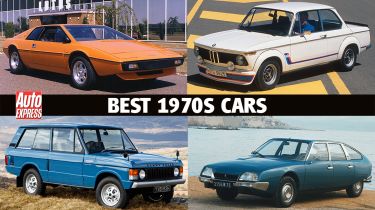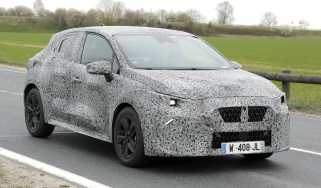Best 70s cars: 30 greatest cars of the 1970s - part two
More of the best cars from the 1970s...
Take a look at part one of our list of the greatest 1970s cars here...
Porsche 928
Although the Porsche 928 wasn’t up to the challenge of replacing the 911, by the time it bowed out in 1995, it had evolved into a formidable GT car. It didn’t get off to the best of starts, with Porsche purists reluctant to embrace the front-engined layout, water-cooled V8 and off-brand styling.
It arrived in 1977 with a 240bhp 4.5-litre V8, with the majority of cars sold with a four-speed automatic. A larger 4.7-litre engine arrived in 1979, with power increased to 300bhp and top speed raised to 152mph. The 5.4-litre GTS of 1992 was the best of the breed.
Mazda RX-7
The NSU Ro80 had done so much to dent the reputation of the Wankel rotary engine, but Mazda’s perseverance with the technology paid off with the launch of the RX-7. The cheaper and better looking alternative to the Porsche 924 sold in good numbers, especially in the United States.
Early cars featured a 105bhp smooth-running rotary engine, but this was upped to 115bhp in 1981. The car also gained rear disc brakes and more equipment as standard. Mazda’s faith in rotary power culminated in a win at Le Mans in 1991.
Citroen SM
The fabulous Citroen DS was so advanced, its production spanned three different decades. The SM of 1970 was just as advanced, but circumstances meant that it didn’t live beyond 1975. Citroen bought Maserati in 1968 and turned to the Italian company for its V8 engine. Two cylinders were removed to create the 2.7-litre V6, with much of the underpinnings shared with the DS.
Robert Opron designed a car that must have looked otherworldly in the early 70s, but the SM was dogged by reliability issues. The fuel crisis and Peugeot’s takeover of Citroen were the nails in the coffin for this fabulous car.
Mercedes-Benz W123
Today’s E-Class can trace its roots back to the W123 of 1976. Mercedes-Benz started development in 1968 with the aim of building the world’s finest saloon car. An S-Class for the masses, with the latest safety equipment, outstanding build quality and superb ride comfort.
The W123 spawned the first Mercedes-Benz estate (‘T’ for Touring and Transport), along with a spacious coupe (‘S’ for Stationswagen). A total of 2.7 million were built before production ceased in 1985, with the durable 240D one of the most successful exports. Like so many cars of the era, rust is the enemy of the W123, but this is a saloon car you can use every day.
Jaguar XJ12
Although the Jaguar XJ6 arrived in 1968, the family saloon came of age in the 1970s. Key to this was the launch of the XJ12, which drew power from a 5.3-litre V12 engine. All XJ12 versions came with the longer-wheelbase body, which meant more interior space. A Jaguar that could live up to the promise of ‘grace, space and pace’.
Fuel injection arrived in 1975, while an improved GM400 automatic transmission was fitted from 1977. If you didn’t require the space, the XJ-C featured an elegant two-door coupe body and a choice of engines.
Porsche 911 Turbo
Turbocharging catapulted the Porsche 911 into the big league. Unveiled at the 1974 Paris Motor Show, the 911 Turbo may have been expensive, but it could sprint to 60mph in just 5.1 seconds. This was in a time when such acceleration was the preserve of Italian supercars with huge, thirsty engines.
The 911 Turbo (930) could do this with a 3.0-litre air-cooled engine producing 230bhp. At the back, the Turbo featured a flat rear spoiler that would become its signature feature through the late 70s and 80s. A larger 3.3-litre engine arrived in 1977 to see the 911 Turbo through to 1989.
Lamborghini Countach
The Lamborghini Countach was the pin-up star for a generation of young petrolheads growing up in the 70s and 80s. Launched in 1974, the Countach had the tough task of replacing the beautiful Miura. It did so in dramatic style, thanks to Gandini’s wedge-like styling and upward-opening doors.
Its 4.0-litre V12 engine produced 385bhp, which was enough to propel the original LP400 to 60mph in 5.2 seconds, before hitting a top speed of 180mph. More powerful versions followed as the styling grew ever more outlandish throughout the 1980s. The last Countach was built in 1990.
Rover SD1
Thirteen years after the Rover P6 scooped the inaugural European Car of the Year award, the SD1 did it again for Rover. Launched in 1976, the SD1 had the potential to be a class-leading family car good enough to rub shoulders with the world’s best. It certainly had the styling, albeit with more than a subtle hint of the Ferrari Daytona.
The 3500 V8 was the undoubted star of the show, although six-cylinder, four-cylinder and diesel engines followed. Early cars were dogged by the standard British Leyland issues, and although overall quality improved, the SD1 could never recover.
Plymouth Superbird
Although this list is focused on cars sold in the UK, the Plymouth Superbird will be familiar to anyone who has been to the Goodwood Festival of Speed. Young car enthusiasts will recognise it as Strip “The King” Weathers from the Cars film franchise.
The pointed shark nose and huge rear wing were designed to cut through the air and make the car a formidable force in NASCAR. Its V8 engines ranged from a 375bhp 7.2-litre V8 to the famous 7.0-litre V8 ‘Hemi’. The road-going Road Runner versions were actually quicker than the race cars, because they didn’t have the weight of the steel and giant wing.
BMW 3.0 CSL
The BMW 3.0 CSL was a true thoroughbred of the 1970. Built to allow BMW to go saloon car racing, early versions of the CSL looked similar to the standard CSi. All that changed with the arrival of the iconic ‘Batmobile’, which showcased BMW’s experimentation with aerodynamics.
Highlights of the ‘Batmobile’ included a roof spoiler, huge boot spoiler and even aerodynamic aids on the bonnet. Only 39 of these desirable rarities were ever produced. Power came from a 3.0-litre six-cylinder engine, with the more subtle road cars producing 206bhp.
BMW 2002 Turbo
Not to be outdone, the BMW 2002 Turbo was the first European turbocharged production car and the ultimate incarnation of the BMW 02-Series. Its launch in 1973 coincided with the energy crisis, so sales were limited, even if the 2.0-litre turbocharged engine was reasonably economical. As it is, just 1,672 were built during a single year of production.
The front spoiler on press cars featured ‘2002 turbo’ written in reverse script, so that anyone travelling in front of the 130mph BMW could see what was approaching behind them. This was promptly deleted when the press accused BMW of being irresponsible.
Mercedes-Benz SL
The SL for the 1970s arrived in 1971, but it proved to be so popular, production continued until 1989. By that time, a total of 237,287 open-top two-seaters had found a home, with the Mercedes-Benz W107 particularly popular in the United States. The SLC (‘C’ stood for coupe’) premiered in October 1971 and was available until 1981.
This was the first time the Mercedes-Benz SL had been available with an eight-cylinder engine, with the car launching as the 350 SL. Although the SL was more a grand tourer than a sports car, the 500 SL had a terrific turn of pace.
Citroen CX
Not many car manufacturers can claim to have built three iconic cars in a decade. The GS and SM had arrived in 1970, but by then, Citroen’s attention had turned to the difficult task of replacing the DS. This job was left to the CX, a car many people believe was the last true Citroen.
It was brimming with technology, including self-levelling hydropneumatic suspension, hydraulic brakes and, standard from 1975, Vari-Power self-centering steering. Thanks to a top speed of 137mph, the CX-25 GTi Turbo-2 was the fastest French car of the era. Production of the CX continued until 1991.
Saab 900 Turbo
More commonly associated with the 1980s, the Saab 900 actually arrived in 1979. It was developed from the 99, but the larger and more sophisticated 900 propelled Saab into the big league, thanks in no small part to the legendary 900 Turbo. Its quirkiness and eccentricity attracted a legion of Saab fanatics, which helped the 900 to continue until 1993, by which time nearly a million cars had been produced.
The non-turbocharged models were safe, comfortable and a tad lethargic, while the 900 Turbo offered exhilarating performance. Turbo lag of the original models was, up to a point, reduced by the mid-80s.
Volvo 240
The Volvo 240 replaced the venerable 140 and enjoyed nearly two decades in production. Whether you see it as a 1970s or a 1980s classic depends on your age – many children will remember trips to the seaside and family holidays in the back of a Volvo estate. Early cars were known as the 242 (two-door), 244 (four-door) and 245 (estate), although all cars adopted the 240 name in 1981.
In Britain, the Volvo 240 became a symbol of middle class life – it seemed like the cars came with a dog and a pair of green wellies as standard.
Caterham Super Seven
Caterham’s decision to secure the rights to the Lotus 7 was a stroke of genius. Although it dated back to 1957, Caterham had the foresight to realise that the need for a driver-focused, lightweight and hardcore sports car would never diminish. It’s why the car has enjoyed such a long life.
Thirty cars aren’t enough to showcase the breadth of cars available in the 1970s. Our shortlist could have been significantly longer if we could feature the many cars that didn’t make the cut. Some could easily replace the cars we selected.
What about the decades before and after? Find out below...



